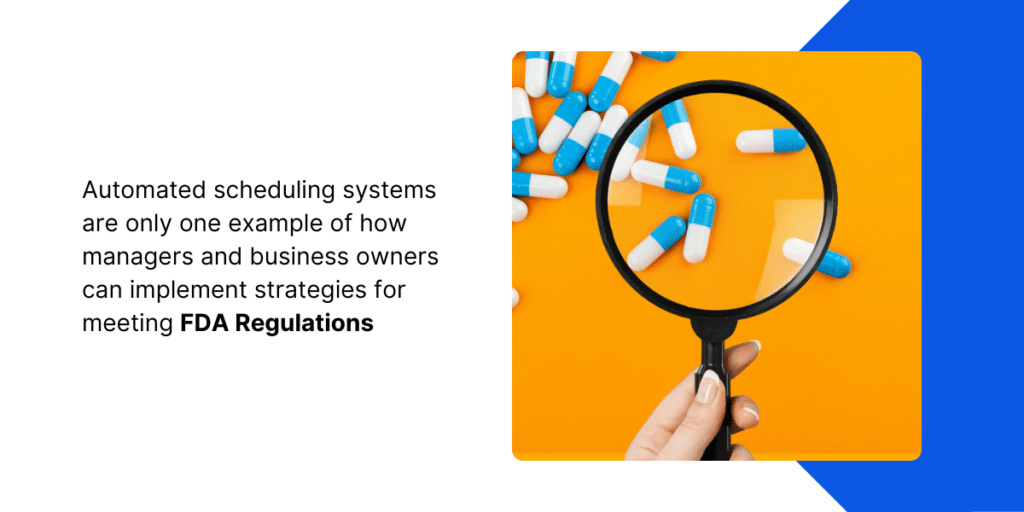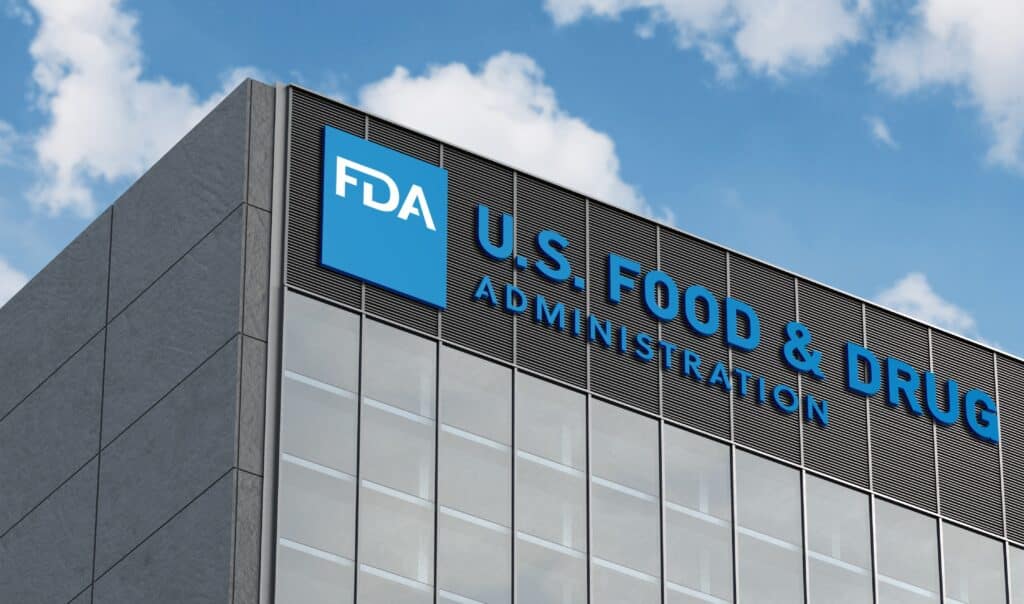For food processors in the U.S., sticking to Food and Drug Administration (FDA) training guidelines isn’t just about ticking boxes—it’s about safeguarding the food we eat. When every employee is up to speed on FDA regulations, there are fewer chances for foodborne illnesses, contamination, or other hazards. It’s about keeping our food safe and our customers healthy.
Non-compliance with FDA training regulations carries serious consequences. Facilities that fail to meet these standards may face severe legal risks, including fines, penalties, and potential shutdowns. Beyond financial repercussions, non-compliance can also damage their reputation, erode consumer trust, and result in costly recalls. Studies show that 55% of consumers would switch brands temporarily following a recall… with 21% avoiding purchasing any brand made by the manufacturer of that recalled product.
These risks underscore the critical need for effective training and compliance management. The skills of the workforce directly impact product quality and, by extension, consumer satisfaction. High-quality food products are the result of precise, skilled work at every stage of the production process. When workers are skilled and knowledgeable, they are better equipped to produce food that meets the highest standards of quality.
That’s why investing in continuous training programs is crucial for maintaining compliance and ensuring operational excellence. Yet, navigating the maze of FDA training requirements can be a real headache for food processing facilities. Let’s dive into the essentials of FDA-compliant training, the common challenges in staying compliant, and how modern workforce management solutions can simplify the process and protect your operations.
Key Components of FDA-Compliant Programs
Before we discuss the specific FDA training requirements, it’s important to understand the foundational elements that all these requirements share. An FDA training program focuses on building a comprehensive approach that ensures food safety, quality, and regulatory compliance—at every level of the organization.
Employee Roles and Responsibilities
A cornerstone of any FDA-compliant training program is the clear definition of employee roles and responsibilities concerning food safety and compliance. Every employee, from the production line to the management team, plays a unique role in maintaining food safety standards. Training programs must ensure that each employee understands:
- Specific Duties: Employees need to know exactly what their role entails, from handling raw materials to operating equipment. This includes understanding how their specific tasks contribute to the overall safety of the food products.
- Reporting Responsibilities: Employees must be aware of the proper channels for reporting safety concerns, potential hazards, or breaches in protocol. This includes knowing who to report to, what information to provide, and how to document the issue.
- Adherence to Food Safety Practices: Employees must recognize the importance of adhering to established food safety practices and protocols. This includes understanding the reasons behind these practices and how failing to comply can lead to serious health risks, legal issues, and damage to the company’s reputation.
Required Knowledge Areas
FDA-compliant training programs must cover several key knowledge areas to ensure a comprehensive understanding and implementation of food safety practices. These areas include an employee’s ability to:
- Food Safety: Prevent foodborne illnesses by being familiar with various types of hazards—microbiological (e.g., bacteria and viruses), chemical (e.g., pesticides or cleaning agents), and physical (e.g., metal shards or glass)—and how to control them.
- Sanitation: Understand the importance of maintaining personal hygiene to prevent contamination. Know proper cleaning and sanitizing techniques, the use of appropriate chemicals, and the scheduling of routine cleaning operations.
- Hazard Control: Identify critical control points (CCPs) in the production process, establish monitoring procedures, and implement corrective actions when needed. Understand preventive controls for mitigating risks identified in the food safety plan.
- Regulatory Requirements: Be well-versed in the various FDA regulations and guidelines that apply to their specific roles. Understand why they are in place and how to comply with them effectively.
Frequency and Documentation of Training
Consistent practices and proper record-keeping ensure ongoing compliance and preparedness for FDA audits and inspections. FDA regulations require that employees are up-to-date on the latest food safety practices and regulatory changes. This includes initial training for new hires and refresher courses for existing employees, particularly when there are updates to regulations or changes in procedures. These sessions can also pinpoint and address any observed gaps in knowledge or performance, providing opportunities for continuous improvement.
Comprehensive documentation of these training activities is essential for demonstrating compliance during FDA audits and inspections. Facilities are generally required to keep their training documentation for at least two years from the date of the training. Records include:
- Attendance Logs: Tracking who attended each training session.
- Training Content: Documenting the topics covered, materials used, and key takeaways.
- Assessment Results: Recording the outcomes of any quizzes or evaluations conducted to gauge employee understanding and retention of the material.

Compliance Challenges
Maintaining compliance requires continuous effort and adaptability, especially as regulations evolve and operational dynamics shift. Let’s explore the key compliance challenges that companies commonly face.
Keeping Up With Evolving Regulations and Guidelines
The regulatory environment for food processing is constantly changing. New guidelines, updates to existing regulations, and the introduction of more stringent standards can make it difficult for companies to stay current.
Many food processing companies, particularly smaller facilities, may lack dedicated compliance teams or sufficient resources to constantly monitor regulatory changes and implement necessary updates. This can lead to delays in updating processes and training programs, increasing the risk of non-compliance. As regulations evolve, companies must interpret how changes impact their operations and ensure that all relevant procedures and documentation are updated accordingly.
Spreadsheets and manual records lack the dynamic capabilities needed to easily update or integrate new regulatory changes across all compliance documentation. When new regulations are introduced, manually updating numerous spreadsheets is cumbersome, time-consuming, and prone to errors. This increases the risk of inconsistencies and gaps in compliance, as critical updates might be overlooked or incorrectly documented.
Managing Training Programs Across Diverse Roles and Locations
Food processing facilities have a diverse workforce with varied roles, from frontline production staff to quality control managers and laboratory technicians. Each of these roles requires specific training tailored to their duties and responsibilities:
Employees need training in different areas, such as sanitation procedures (SSOPs), food allergen control, and emergency response. The challenge lies in developing and implementing training programs that address the unique needs of each role while ensuring consistency and compliance across the organization.
For companies operating multiple facilities across different locations, managing a standardized training program becomes even more complex. Variations in local regulations, language barriers, and cultural differences can impact the effectiveness of training programs and create compliance gaps.
Using spreadsheets to track training for a diverse workforce across multiple locations is highly inefficient. Spreadsheets can become disorganized and challenging to manage, especially when trying to account for various training requirements and schedules. Coordinating training across different shifts, languages, and locations manually can lead to missed sessions or incomplete training records, increasing the risk of non-compliance.
Ensuring Comprehensive Documentation and Record-Keeping for Audits
Accurate documentation is a cornerstone of FDA compliance, providing proof that a company has met all regulatory requirements. However, maintaining comprehensive records can be daunting.
Food processing facilities must keep detailed records of all training activities, monitoring results, corrective actions, and verification procedures. This includes documentation for preventive controls, allergen management, and sanitation procedures, as well as employee health and hygiene training. The sheer volume of these records, coupled with the complexity of managing them, poses a significant challenge.
During FDA audits or inspections, facilities must quickly provide documentation to demonstrate compliance. Poor record-keeping or incomplete records can lead to compliance issues, fines, or even shutdowns. Ensuring that all records are accurate, up-to-date, and easily accessible is essential for audit readiness.
Manual tracking methods like spreadsheets are not designed for comprehensive documentation management. They lack built-in audit trails, making it difficult to verify who made changes and when, which is crucial for audit readiness. Additionally, maintaining vast amounts of data in spreadsheets can lead to data fragmentation, where records are incomplete, duplicated, or lost, making it challenging to provide accurate documentation during an audit.
High Employee Turnover
High employee turnover and a workforce with varied skills and experience levels can significantly impact a facility’s ability to maintain compliance. High turnover rates mean that new employees are constantly being onboarded, each requiring comprehensive training to understand their roles and the facility’s food safety protocols. This creates a continuous need for training resources and can strain a facility’s capacity to maintain consistent compliance.
With employees possessing different levels of experience and expertise, there is a risk of inconsistent application of food safety practices. Variations in skills and knowledge can lead to mistakes or lapses in compliance, particularly if new or inexperienced employees are not adequately trained or supervised.
Relying on spreadsheets to track training for a constantly changing workforce is not only time-consuming but also inefficient. Spreadsheets do not provide automated reminders or updates, making it easy to miss retraining opportunities or fail to onboard new employees properly. This can result in skill gaps, inconsistent application of food safety practices, and ultimately, lapses in compliance.

The Role of Technology
Manual processes only compound these challenges.
- Human Error and Inaccuracy: Spreadsheets are prone to human error, such as data entry mistakes, formula errors, or accidental deletions. These errors can lead to inaccurate training records, incomplete compliance documentation, and ultimately, compliance gaps.
- Lack of Real-Time Visibility: Spreadsheets do not offer real-time updates or insights into compliance status. Facilities may not be aware of training gaps, missed deadlines, or incomplete documentation until an audit or inspection occurs, increasing the risk of non-compliance.
- Inefficient Processes: Managing compliance manually through spreadsheets is labor-intensive and inefficient, diverting valuable resources away from other critical food safety activities. This inefficiency can make it harder to respond quickly to regulatory changes or unexpected audits, further increasing compliance risks.
Modern technology solutions play a crucial role in helping food processing companies better adhere to FDA training requirements. By leveraging advanced tools and platforms, companies can automate and streamline many of the labor-intensive and error-prone processes associated with compliance management.
Automation of Training Management
Technology solutions enable the automatic scheduling and tracking of employee training sessions. This ensures that all employees receive the necessary training and refresher courses according to regulatory requirements without the need for manual intervention.
Automated systems generate comprehensive reports on training completion, attendance, and assessment results. These reports are readily available for audits and inspections, reducing the administrative burden on compliance teams and minimizing the risk of human error associated with manual record-keeping.
Centralized Platform for Training Records and Employee Certifications
A centralized digital platform consolidates all training records and employee certifications into a single, easily accessible location. This eliminates the fragmentation of records often caused by using multiple spreadsheets or documents, ensuring consistency and accuracy in documentation.
Centralized platforms also allow for better management of employee skills and certifications, linking these directly to their job roles and responsibilities. This ensures that all employees are adequately trained for their specific duties and that only qualified employees are scheduled for tasks requiring specialized skills. By matching the right employees to the right jobs, these platforms enhance overall food safety and compliance, minimizing the risk of errors and ensuring that every step of the production process is carried out by competent personnel.
Real-Time Alerts for Training Renewals and Compliance Gaps
Modern technology solutions provide real-time alerts and notifications for upcoming training renewals, certifications that are about to expire, or any identified compliance gaps. This proactive approach helps prevent lapses in compliance by ensuring that all employees remain up-to-date with their training requirements.
Real-time capabilities also allow companies to quickly update training programs in response to regulatory changes, ensuring that all employees are promptly trained on new requirements and that the facility remains compliant.
Indeavor for FDA Training Compliance
Indeavor’s workforce management solution offers a robust platform specifically designed to address the compliance needs of food processing facilities. With features that seamlessly integrate with existing systems and provide automated tracking, Indeavor makes it easier for companies to manage FDA training compliance effectively.
Seamless Integration With Existing Systems
Indeavor integrates seamlessly with existing Human Resource Management (HRM), Learning Management Systems (LMS), and Training Management Systems (TMS). This integration allows for comprehensive skills management that considers employee training and certifications at the point of scheduling, ensuring that only qualified personnel are assigned to tasks requiring specific competencies. It also enables a holistic view of employee skills and certifications, facilitating better workforce planning and ensuring that all regulatory training requirements are met.
Automated Tracking of Employee Training and Certifications
Indeavor’s platform automates the tracking of employee training and certifications, ensuring that records are always up-to-date and easily accessible. This reduces the risk of manual errors and ensures that all employees are compliant with FDA training requirements. All training records are maintained digitally, eliminating the need for cumbersome paper records or manual spreadsheets. This ensures data integrity and easy retrieval during audits or inspections.
Real-Time Compliance Monitoring and Reporting Capabilities
Indeavor provides real-time monitoring of compliance status across the entire organization. This includes tracking training completion, certification status, and identifying any compliance gaps or upcoming renewals. The platform can instantly generate compliance reports, making it easier to demonstrate compliance during audits and respond to any regulatory inquiries. This feature greatly enhances audit readiness and reduces the administrative burden on compliance teams.
By leveraging modern technology solutions like Indeavor’s workforce management platform, food processing companies can streamline their FDA training compliance processes, reduce the risk of non-compliance, and ensure they are always prepared for regulatory changes or audits. This proactive approach not only enhances operational efficiency but also safeguards the company’s reputation and ensures the safety of the food products they produce







